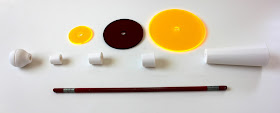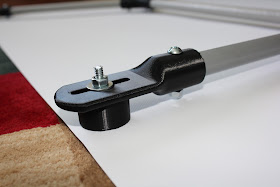On Christmas day this past year I placed an order for a new Creality CR-10 S4 3D printer. I was amazingly surprised to have it in my hands three days later. Along with the new printer the next day I ordered an upgrade to the heating element for the printer as I wanted to 3D print using ABS filament. I found after research that the stock heating element had a hard time coming up to the 110C temperature so that was my reasoning to update it right off the bat. The new Keenovo heating element I ordered the day after Christmas and it took seven weeks to get it into my hands thanks to Customs holding on to it in New York most of that time. But no matter what things have been looking up since this long wait and I now am able to show you the end results.
Here is my new 3D printer in the new enclosure that I completed shortly after the new heating element was installed a few days ago. The enclosure I lucked out with as far as materials for it was concerned as I had a pile of 3/4 inch square aluminum tubing stored away in my shop that was perfect for the job. I 3D printed all the connecting components on my original Makerbot Replicator and then covered the outside with 10 mil plastic. Nice and heavy and very clear compared with other plastics I had looked at.
Here is a good shot of the interior of the enclosure with the new printer. Lots of room and I was lucky to have just enough space on my old drafting table to hold it all without it looking out of place.
The large black box in the image above is the control box for the Creality CR-10 S4 printer. Next to it is a smaller controller for the Keenovo heating element (reading 106.1).
Here's a closer look at the Keenovo heating element control box. Very simple and very fast heat up with this new unit. A vast improvement over the original heating element that comes with the Creality printer. My Makerbot 3D printer takes around 8 minutes to come up to temperature to print ABS filament. With this new heater it only takes around two minutes.
Here's a good look at my design for the enclosure for the 3D printer that I put together using Fusion 360 CAD software. The enclosure is 27.5 inches wide, 27" tall, and 38" deep. I needed this much space to easily hold the 3D printer and not have it have any issues with movement of the build platform while printing parts.
The two images above show off one of the hinge assemblies that I use for the doors on the enclosure. These were 3D printed and then mounted into the aluminum tubing using 1/4-20 hardware.
Here is a good selection of all the different types of 3D printed connectors that needed to be made for the enclosure. This took some time but being as I was waiting for weeks for the new heating element it was the perfect time to make these components and get the enclosure in shape before it arrived.
Here is the enclosure being put together in the workshop. Being on the work table it gives you a good idea of how large this assembly is. Luckily it is very light weight and at this point can easily be taken apart to move it into my workroom where I actually make 3D printed parts.
Here's another look at the real hinges that are used in the enclosure. I was really pleased with the fit and finish of my design. The doors work perfectly.
At the base of the doors is this 3D printed assembly with a couple of 1/4-20 bolts and nuts attached to it. I needed a good metal target on this part being as both front doors have small magnets mounted in the bottom corners of the 3D printed connectors that make up the framework of each door. These magnets are press fit into the frame and when the doors are closed the magnets click into place on top of the heads of the small bolts in this assembly keeping the doors securely closed. Simple and effective.
Once I had completed assembly of the enclosure and got the new 3D printer up and running I needed to figure out how to route all of the wiring for the 3D printer into the enclosure without causing any issues along the way. On the left side of the enclosure rather than completely seal up the back portion of that side with clear plastic as I had done with all the other sides and doors on the enclosure I left the bottom portion of the plastic unsecured. I did not tape it down as I had done on all the other panels. This allowed me to snake all of the wiring into the enclosure through a small gap at the base of the panel. I also made another small gap that runs vertically near the center of the enclosure on the left side. This allowed me to route additional wiring and the plastic filament for the printer's extruder into the enclosure. I wanted to keep these openings as small as possible to retain the heat that is needed to make good ABS plastic parts.
One feature that I always wanted on my 3D printer that I did not have on my Makerbot was a WiFi video camera. So I installed one into the new enclosure. I picked up this nice little security camera at Walmart and worked out the mount for the camera and located it on the upper front right corner of the enclosure. I can watch any 3D part being made on either my iPad or my phone so I don't have to be sitting in the actual room where the printer is at to keep a eye on it's progress. A good safety feature as well.
I put a thermometer into the enclosure while printing one of the first test parts on the new printer and it read 96 degrees! Plenty warm enough for the printer and a good confirmation that my design for the enclosure is sound. Now all I have to do is make final adjustments to tweak the new printer and I will be making bigger and better parts than ever before. I have already made plans for some rather large projects that will be coming up in the near future and should be a lot of fun to work on. I'll keep you up to date with this new addition to the workshop. Another good day in the shop!




















































